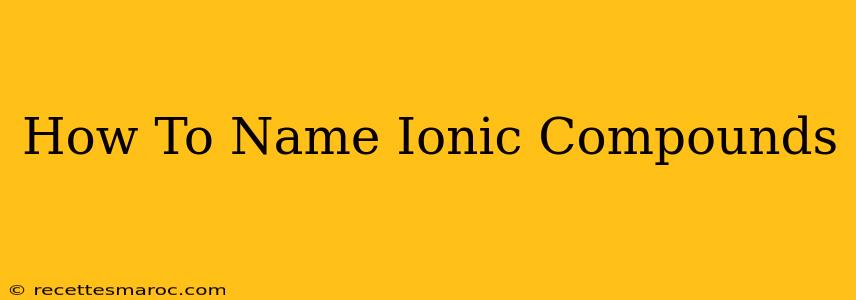Naming ionic compounds might seem daunting at first, but with a systematic approach, it becomes straightforward. This comprehensive guide will walk you through the process, equipping you with the knowledge to confidently name any ionic compound. We'll cover the fundamental rules, provide examples, and address common pitfalls.
Understanding Ionic Compounds
Before diving into naming conventions, let's briefly review what ionic compounds are. Ionic compounds are formed through the electrostatic attraction between oppositely charged ions: cations (positively charged ions) and anions (negatively charged ions). This strong attraction results in a crystalline structure.
The Basic Rules for Naming Ionic Compounds
The naming process for ionic compounds follows a simple, yet crucial, pattern:
-
Name the cation first: The cation's name remains unchanged (unless it can form multiple ions, as we'll discuss below).
-
Name the anion second: The anion's name is modified to end in "-ide".
Examples:
- NaCl: Sodium Chloride (Sodium cation + Chloride anion)
- KBr: Potassium Bromide (Potassium cation + Bromide anion)
- MgO: Magnesium Oxide (Magnesium cation + Oxide anion)
Handling Transition Metals: Roman Numerals to the Rescue!
Transition metals are notorious for forming multiple ions with varying charges. To avoid ambiguity, we use Roman numerals in parentheses after the metal's name to indicate its charge.
How to Determine the Charge:
- Identify the anion's charge: This is usually straightforward (e.g., Cl⁻, O²⁻).
- Use the principle of charge neutrality: The overall charge of the ionic compound must be zero. This means the total positive charge from the cation(s) must equal the total negative charge from the anion(s).
Examples:
- FeCl₂: Iron(II) Chloride (Iron has a +2 charge to balance two Cl⁻ ions)
- FeCl₃: Iron(III) Chloride (Iron has a +3 charge to balance three Cl⁻ ions)
- Cu₂O: Copper(I) Oxide (Each Copper has a +1 charge to balance one O²⁻ ion)
- CuO: Copper(II) Oxide (Copper has a +2 charge to balance one O²⁻ ion)
Polyatomic Ions: Remembering the Names
Polyatomic ions are groups of atoms that carry a net charge. These require memorization, but thankfully, there are only a few common ones. Some examples include:
- Nitrate (NO₃⁻): Found in compounds like Potassium Nitrate (KNO₃)
- Sulfate (SO₄²⁻): Found in compounds like Magnesium Sulfate (MgSO₄)
- Phosphate (PO₄³⁻): Found in compounds like Calcium Phosphate (Ca₃(PO₄)₂)
- Hydroxide (OH⁻): Found in compounds like Sodium Hydroxide (NaOH)
- Ammonium (NH₄⁺): This is a positively charged polyatomic ion, acting as the cation. Example: Ammonium Chloride (NH₄Cl)
Putting it All Together: Complex Examples
Let's tackle some more complex examples incorporating transition metals and polyatomic ions:
- FeSO₄: Iron(II) Sulfate
- Cr(NO₃)₃: Chromium(III) Nitrate
- (NH₄)₂CO₃: Ammonium Carbonate
Common Mistakes to Avoid
- Forgetting Roman numerals for transition metals: Always check if the metal can have multiple oxidation states.
- Incorrectly naming the anion: Remember the "-ide" suffix for monatomic anions.
- Ignoring the charges when dealing with polyatomic ions: Ensure charge neutrality in the compound.
Mastering Ionic Compound Nomenclature
By understanding the fundamental principles and practicing with various examples, you can master the art of naming ionic compounds. This skill is crucial in chemistry, providing a foundation for understanding chemical reactions and properties. Remember to consult a periodic table and a list of common polyatomic ions for reference. With consistent practice, naming ionic compounds will become second nature.

